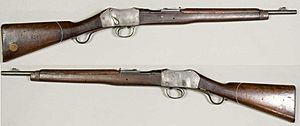Martini–Enfield facts for kids
Quick facts for kids Martini–Enfield Mk I & Mk II |
|
|---|---|

Martini-Enfield carbine. From the Swedish Army Museum.
|
|
| Type | Service rifle |
| Place of origin | United Kingdom |
| Service history | |
| In service | 1895–1918 |
| Used by | United Kingdom & Colonies Afghanistan |
| Wars | British colonial wars, Second Boer War (Limited) World War I (Limited) |
| Production history | |
| Designer | RSAF Enfield |
| Designed | 1895 |
| Manufacturer | RSAF Enfield |
| Produced | 1895–1903 |
| No. built | approx. 250,000–500,000 |
| Variants | Mk II Carbine |
| Specifications | |
| Mass | 8.5 pounds (3.9 kg) empty |
| Length | 49.25 inches (1,251 mm) |
| Barrel length | 30.2 inches (770 mm) (rifle) 21.3 inches (540 mm) (carbine) |
|
|
|
| Cartridge | .303 Mk IIC SAA Ball |
| Calibre | .303 British |
| Action | Martini Falling Block |
| Rate of fire | 10 rounds per minute |
| Muzzle velocity | 2,200 feet per second (670 m/s) |
| Effective firing range | 1,000 yards (910 m) |
| Maximum firing range | 2,000 yards (1,800 m) |
| Feed system | Single shot |
| Sights | Sliding ramp rear sights, fixed-post front sights |
The Martini–Enfield was a type of rifle used a long time ago. It was mostly made by changing older Martini–Henry rifles. These changes allowed them to use a newer, more powerful type of bullet called the .303 British cartridge. Some Martini–Enfield rifles were also built completely new.
Contents
About the Martini-Enfield Rifle
The Martini–Enfield Mk I was an older Martini–Henry Mk III rifle that was updated. It got a new barrel and a new part to pull out the empty bullet casing. The Martini–Enfield Mk II rifles were usually brand new. However, some Mk II rifles were also made by converting older ones.
How the Rifle Changed Over Time
At first, around 1889, the changed Martini–Henry rifles used barrels with a special type of grooving called Metford rifling. This worked well with the first .303 bullets, which used black powder. But these barrels wore out very quickly when newer bullets, using cordite or nitrocellulose, came out in 1895. These newer bullets were called "smokeless" ammunition because they made less smoke.
So, in 1895, a new type of barrel with Enfield rifling was introduced. This barrel was much better for the modern smokeless ammunition.
When and Where the Rifle Was Used
The Martini–Enfield rifle was used by soldiers from 1895 to 1918. For example, Australian forces used them during the Second Boer War (1899–1902). Even during World War I, some groups, like the Arab fighters led by Lawrence of Arabia, used these rifles.
The rifle stayed in use as a backup weapon in places like India and New Zealand even into World War II.
Who Made These Rifles?
Many companies either made new Martini–Enfield rifles or changed old ones. Some of the main manufacturers included:
- RSAF (Royal Small Arms Factory) in Enfield Lock
- LSA Co (London Small Arms Co)
- BSA & M Co (Birmingham Small Arms & Metals Co), which later became BSA
- HRB Co (Henry Rifle Barrel Co)
- NA&A Co (National Arms & Ammunition Co)
These rifles were generally made very well. They can even handle modern .303 British ammunition. However, if you ever find an old firearm, it's super important to have a gunsmith check it first. This makes sure it's safe to use.
Fake Rifles from Khyber Pass
The Khyber Pass is a mountain area between Pakistan and Afghanistan. For a long time, people there have been known for making their own copies of firearms. They use whatever materials they can find, like old railway parts or scrap metal.
How Copies Were Made
When British soldiers were in the North-West Frontier, local people got their hands on rifles like the Martini–Henry and Martini–Enfield. They then started making their own versions. Later, they also copied the Lee–Enfield rifles.
Dangers of Fake Rifles
The quality of these homemade rifles can be very different. Some might be almost as good as factory-made ones. But many are very dangerous to use. The bullets used with these copies are often not made correctly. They might use different powders or even old film, which can be risky.
Because of this, these "Khyber Pass Copy" rifles usually cannot handle the strong pressure from modern bullets. Using them can be very dangerous. It's generally advised not to fire these weapons. Some collectors might use very weak, custom-made bullets for them. But this is still not recommended, and anyone who fires them does so at their own risk.
How to Spot a Fake
You can often tell a Khyber Pass Copy by a few things:
- Spelling mistakes: Look for errors in the markings on the rifle. A common one is a backwards "N" in "Enfield."
- Wrong dates: Some fakes might have "V.R." (Victoria Regina) markings dated after 1901. Queen Victoria died in 1901, so rifles made after that year should say "E.R." (Edward Rex), for King Edward VII.
- Poor quality: The overall work might look bad. The metal might be weak, the wood might not be finished well, and the markings might look messy.
Many different fake rifles were once sold in markets near military bases in Afghanistan. These included copies of Martini–Henrys and other old British rifles. Some fakes had no British markings at all. Instead, they had Middle Eastern designs. After rules changed about bringing these fakes into markets, sellers started bringing fake muzzle-loading "Tower" rifles. These were sold as souvenirs. While some sellers might claim they are real, most do not say anything about their true origin.

